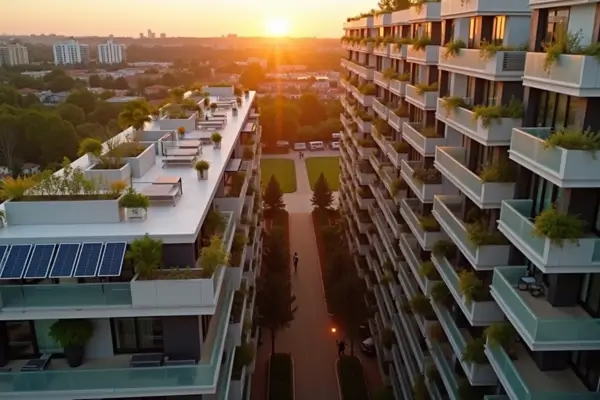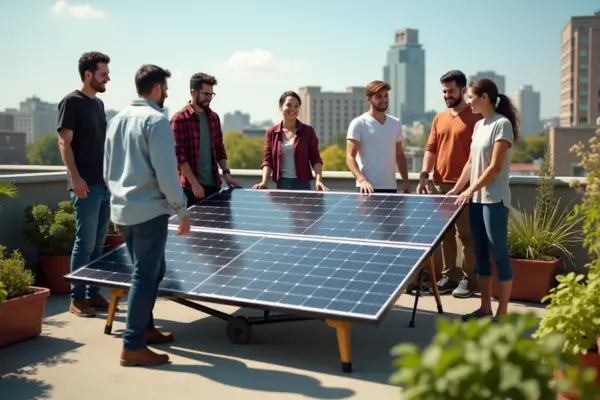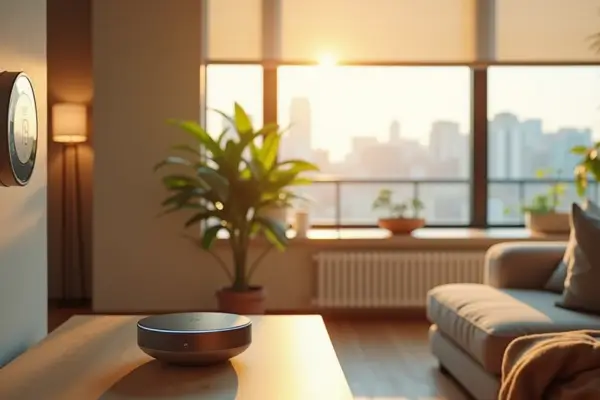Every day, our energy use, transportation choices, and consumption habits contribute to our carbon footprint—the total amount of greenhouse gases we generate through our actions. As climate change accelerates, reducing this footprint has become more crucial than ever. But for apartment dwellers, going green isn’t always straightforward. Unlike homeowners, renters often can’t install solar panels, upgrade insulation, or replace old appliances—yet that doesn’t mean they’re powerless.
Apartment living comes with unique challenges when it comes to sustainability. Strict leasing agreements, limited space, and lack of control over building infrastructure can make eco-friendly upgrades feel out of reach. However, with a little creativity and resourcefulness, renters can still significantly cut their carbon emissions and embrace apartment-friendly green energy solutions.
From switching to renewable energy providers to making small, no-permission-needed efficiency upgrades, there are plenty of ways to live more sustainably—even in a rental. In this guide, we’ll explore practical, budget-friendly strategies to reduce your carbon footprint without needing a landlord’s approval (though we’ll also cover how to advocate for bigger green changes in your building).
Whether you’re in a compact studio or a high-rise apartment, you can make a difference. Let’s dive in!
Understanding Your Carbon Footprint as a Renter
As a renter, you might wonder exactly how your daily habits impact the planet. While you may not own your living space, your choices still contribute to your carbon footprint—the total greenhouse gas emissions caused directly or indirectly by your lifestyle. Let’s break down the key factors:
What Contributes to a Renter’s Carbon Footprint?
1. Electricity Use
- Lighting, electronics, and appliances – Leaving devices on standby, using inefficient bulbs, and running energy-hungry gadgets all add up.
- Air conditioning & heating – HVAC systems are often the biggest energy drain in apartments.
2. Heating & Water Usage
- Gas or electric heating – Older buildings with poor insulation waste energy, forcing heating systems to work harder.
- Hot water consumption – Long showers, frequent laundry loads, and inefficient water heaters increase emissions.
3. Waste & Consumption Habits
- Single-use plastics & packaging – Takeout containers, disposable products, and excessive online shopping deliveries generate waste.
- Food waste – Discarded food in landfills produces methane, a potent greenhouse gas.
4. Transportation (Even as a Renter!)
- Commuting – Gas-powered cars, ride-shares, and even public transit (depending on energy sources) contribute to your footprint.
- Delivery services – Frequent Amazon orders or meal deliveries mean more trucks on the road.
Why Reducing Your Energy Consumption Matters—Even in a Rental
You might think, “I don’t own this place—why should I bother?” But cutting your carbon footprint as a renter has real benefits:
✅ Lower Utility Bills – Energy-efficient habits (like unplugging devices or using LED bulbs) can noticeably reduce your monthly costs.
✅ Healthier Indoor Air – Reducing reliance on gas heating or opting for non-toxic cleaning products improves air quality.
✅ Influencing Landlords & Neighbors – When renters demand greener options (like recycling programs or energy-efficient appliances), property managers take notice—leading to bigger changes.
✅ Future-Proofing Your Lifestyle – Sustainable habits you build now will carry over when you move into your next home (whether rented or owned).
Even small adjustments can make a difference. In the next sections, we’ll explore practical, renter-friendly ways to shrink your carbon footprint—without needing to break a lease!
Apartment-Friendly Green Energy Solutions
Just because you rent doesn’t mean you can’t tap into clean energy and slash your carbon footprint. From renewable power options to simple efficiency hacks, here’s how to make your apartment greener—without needing your landlord’s approval (in most cases).
A. Renewable Energy Options for Renters
1. Community Solar Programs
No rooftop? No problem. Many states now offer community solar—shared local solar farms where you can subscribe to clean energy without installing panels.
- How it works: You pay for a portion of a solar farm’s output, and your utility bill gets credited for the energy produced.
- Where to sign up: Check EnergySage or your local utility’s website for programs.
2. Green Energy Providers
If your state allows energy choice, switch to a renewable energy supplier that sources power from wind, solar, or hydro.
- Options to explore: Companies like Arcadia, CleanChoice Energy, or your utility’s green power plan.
- Bonus: Some providers lock in rates, potentially saving you money long-term.
3. Portable Solar Panels
For DIY clean energy, try small solar panels designed for balconies or windows.
- Best for: Charging phones, laptops, or small appliances.
- Popular picks:
- Bluetti Solar Panels (foldable & lightweight)
- Renogy 100W Briefcase Solar Kit (great for renters)
B. Energy Efficiency Upgrades (No Landlord Permission Needed)
1. LED Lighting
The quickest win for energy savings. Swap out old incandescent bulbs for LEDs, which use 75% less energy and last years longer.
- Tip: Look for warm white bulbs (2700K–3000K) to avoid harsh lighting.
2. Smart Power Strips
Stop “vampire energy” drain from devices like TVs, game consoles, and chargers.
- How they work: They cut power to devices in standby mode.
- Top pick: Kasa Smart Power Strip (programmable via app).
3. Energy-Efficient Appliances
When replacing gadgets, choose ENERGY STAR-certified models:
- Mini-fridges
- Air purifiers
- Microwaves & blenders
C. Sustainable Heating and Cooling
1. Thermal Curtains & Window Insulation
- Winter: Heavy thermal curtains trap heat inside.
- Summer: Reflective window film blocks sun, reducing AC use.
- Budget hack: Use bubble wrap as temporary insulation on windows.
2. Programmable Thermostats (If Allowed)
If your apartment has a central thermostat, ask your landlord about installing a Nest or Ecobee to optimize heating/cooling schedules.
3. Fans & Natural Ventilation
- Ceiling fans: Run counterclockwise in summer, clockwise in winter to circulate air efficiently.
- Cross-breezes: Open windows at night to cool your apartment naturally.
D. Reducing Energy Consumption Daily
1. Unplugging Devices
- “Phantom load” from idle devices can add $100+/year to bills.
- Fix it: Unplug or use smart plugs for electronics like:
- Coffee makers
- Laptop chargers
- Gaming consoles
2. Laundry & Dishwashing Tips
- Wash clothes in cold water (saves energy on water heating).
- Air-dry dishes instead of using the dishwasher’s heat-dry setting.
3. Mindful Cooking
- Use smaller appliances (microwave, toaster oven, Instant Pot) instead of the oven when possible.
- Keep lids on pots to cook food faster.
Next Steps
These changes might seem small, but they add up! In the next section, we’ll cover how to advocate for bigger green upgrades in your building.
Which tip will you try first? Let us know in the comments!

Sustainable Water Usage in Apartments: Save Water & Energy Easily
When we think about reducing our carbon footprint, water conservation often gets overlooked. But in an apartment, saving water directly cuts energy use too—especially since heating water accounts for nearly 20% of a home’s energy consumption. Here’s how renters can dramatically reduce water waste (often without needing landlord approval).
1. Low-Flow Showerheads & Faucet Aerators
The Problem: Standard showerheads use 2.5+ gallons per minute (GPM)—that’s 25+ gallons for a 10-minute shower!
The Fix:
✅ Install a low-flow showerhead (1.5 GPM or less) – Cuts water use by 40% without sacrificing pressure.
✅ Add faucet aerators – Mixes air with water, reducing flow while maintaining strong stream.
✅ Renter-friendly? Yes! These screw on easily and can be swapped back when you move.
💡 Pro Tip: Look for WaterSense-labeled products (EPA-certified for efficiency).
2. Fixing Leaks Promptly
The Problem: A dripping faucet or running toilet can waste hundreds of gallons per month—plus, hot water leaks mean wasted energy.
The Fix:
✅ Check for leaks – Place a drop of food coloring in the toilet tank—if it seeps into the bowl without flushing, you have a leak.
✅ Tighten faucets – Often, a loose handle is the culprit.
✅ Report major leaks – If pipes or toilets need repairs, notify your landlord ASAP.
💰 Bonus: Many cities offer free water-saving kits (check your local utility website).
3. Collecting & Reusing Water
The Problem: Letting clean water go down the drain wastes a precious resource.
The Fix:
✅ Shower bucket method – Place a bucket in the shower while water warms up, then use it to water plants or flush toilets.
✅ Pasta/veggie water – After boiling, let it cool and use it to hydrate houseplants (nutrient-rich!).
✅ Dehumidifier water – If you run a dehumidifier, reuse the collected water for cleaning or plants.
🌱 Eco-Hack: Keep a watering can near your sink for easy reuse.
Why This Matters for Renters
- Lower utility bills (especially if you pay for water).
- Less strain on building plumbing (fewer leaks = fewer maintenance hassles).
- Energy savings (since less hot water wasted = less energy used).
Next Up: How to reduce waste in your apartment (even without a compost bin!).
Which water-saving tip will you try first? Let us know in the comments! 💧

Waste Reduction & Eco-Friendly Living Habits for Renters
Living sustainably in an apartment isn’t just about energy—it’s also about reducing waste. The average American generates 4.9 pounds of trash per day, much of which ends up in landfills. But as a renter, you can still make a big difference with these space-smart, landlord-friendly waste-cutting strategies.
1. Composting in Small Spaces
Myth: “I need a backyard to compost!”
Reality: Even tiny apartments can compost!
Options for Renters:
✔ Electric Composters (Like Lomi or FoodCycler)
- Break down food scraps in 24 hours into odorless, nutrient-rich dirt.
- No smells, no pests—perfect for studios.
✔ Bokashi Bins
- Ferments food waste (even meat/dairy!) using microbes.
- Small, airtight, and fits under the sink.
✔ Community Drop-Offs
- Many cities now have compost collection bins at farmers’ markets or grocery stores.
- Apps like ShareWaste connect you with neighbors who compost.
♻ Pro Tip: Keep a small countertop bin (with a charcoal filter) for food scraps until you’re ready to compost.
2. Recycling & Upcycling Like a Pro
Recycling in apartments can be tricky—but doing it right keeps waste out of landfills.
Do’s & Don’ts:
✅ DO recycle:
- Clean cardboard, paper, glass, and rigid plastics (check local rules).
- Electronics & batteries (many stores like Best Buy accept them).
🚫 DON’T “wishcycle” (tossing non-recyclables in the bin, which contaminates loads):
- No greasy pizza boxes, plastic bags, or disposable coffee cups.
Upcycling Hacks:
♻ Turn jars into storage (spices, DIY candles, or bulk-bin purchases).
♻ Use old T-shirts as cleaning rags (ditch paper towels!).
♻ Repurpose wine corks as plant markers or DIY coasters.
3. Minimalist & Low-Waste Shopping
Less stuff = less waste. Here’s how to shop smarter in a rental:
Bulk Buying (Even in Small Spaces):
🛒 Use reusable bags/containers at stores like Whole Foods or local co-ops.
🛒 Buy pantry staples in bulk (rice, beans, nuts) to cut packaging waste.
Plastic-Free Swaps:
🌿 Solid shampoo bars instead of bottled shampoo.
🌿 Bamboo toothbrushes & safety razors.
🌿 Reusable produce bags (or just skip the bag—does that cucumber really need one?).
Secondhand & Borrowing:
🔄 Thrift furniture & decor (Facebook Marketplace, OfferUp).
🔄 Borrow tools/kitchen gadgets you rarely use (from neighbors or libraries).
Why This Matters for Renters:
✔ Less clutter = easier moves.
✔ Lower costs (bulk/used items are cheaper).
✔ Healthier home (fewer plastic toxins, cleaner air).
Next Up: How to convince your landlord to make eco-upgrades (like recycling bins or energy-efficient appliances!).
Which waste-reduction habit will you try first? Tell us below! ↓
Advocating for Green Changes in Your Building
Just because you don’t own your apartment doesn’t mean you can’t push for bigger sustainability improvements. Many landlords are open to eco-friendly upgrades—especially if they save money in the long run. Here’s how to effectively advocate for green changes in your rental building.
1. Talking to Landlords About Energy-Efficient Upgrades
Landlords care about two things: Cost savings and property value. Frame your requests around these benefits.
Pitch These Upgrades:
✅ LED Lighting for Common Areas
- *”This could cut the building’s lighting costs by 50-75%.”*
✅ Smart Thermostats
- “These optimize heating/cooling, reducing energy bills for the whole building.”
✅ Water-Saving Fixtures
- “Low-flow showerheads and faucets lower water bills with no downside for tenants.”
How to Approach Them:
- Email a professional proposal with cost/savings estimates.
- Suggest incentives: Some utilities offer rebates for landlords who upgrade.
- Offer to help coordinate (research installers, apply for rebates).
2. Proposing Recycling or Composting Programs
Many apartments still don’t recycle—but you can change that.
Steps to Get a Recycling Bin:
- Check local laws—some cities require landlords to provide recycling.
- Gather tenant interest (petitions help!).
- Propose a trial program (start with one bin in a common area).
Composting for Apartments:
- Suggest a communal compost bin in a courtyard or garage.
- Partner with a local compost service (some pick up for a small fee).
3. Joining or Starting a Tenant Sustainability Group
Collective action gets results. Here’s how to organize:
If Your Building Has a Group:
- Attend meetings and push for green initiatives.
- Propose energy-saving challenges (e.g., “Who can reduce their usage the most?”).
Starting Your Own Group:
- Find like-minded neighbors (start with a flyer or chat in the lobby).
- Host a casual meetup (discuss easy wins first, like recycling).
- Divide tasks (e.g., one person researches rebates, another talks to management).
Bigger Projects to Push For:
- Bike storage (encourages low-carbon commuting).
- Solar panel installations (some states offer incentives for multifamily buildings).
- Electric vehicle charging stations (increases property value).
Why This Works:
Landlords are more likely to listen when multiple tenants ask for changes. Even small wins (like a recycling bin) pave the way for bigger improvements.
Next Up: How to offset your carbon footprint when you can’t make all the changes you want.
Have you successfully pushed for green changes in your building? Share your tips below! 👇

Offsetting Your Carbon Footprint (When You Can’t Eliminate It)
Even with the best efforts, some carbon emissions are unavoidable—especially in rentals where you can’t control everything. The good news? You can still balance out your impact through smart offsets and sustainable habits. Here’s how renters can make a difference beyond their four walls.
1. Supporting Carbon Offset Programs
How it works: Carbon offsets fund projects (like reforestation or renewable energy) that remove or prevent emissions equal to your footprint.
Best Options for Renters:
🌱 Terrapass – Offsets flights, driving, or home energy use.
🌱 Gold Standard – Supports verified clean energy projects worldwide.
🌱 NativeEnergy – Helps build new wind/solar farms.
💰 Budget tip: Some programs let you offset just one part of your life (e.g., only your flights).
2. Planting Indoor Air-Purifying Plants
Double benefit: Plants absorb CO₂ and filter toxins like formaldehyde (common in apartments).
Best Low-Maintenance Picks for Renters:
🪴 Snake Plant – Thrives in low light, needs water only every 2–3 weeks.
🪴 Pothos – Grows fast, perfect for shelves or hanging planters.
🪴 Spider Plant – Removes pollutants and sprouts “babies” to share with neighbors.
🌿 Pro tip: Check your lease—many allow plants if they don’t damage walls/floors.
3. Eco-Friendly Transportation Choices
Apartments often have great transit options—use them!
Renter-Friendly Ways to Cut Commute Emissions:
🚲 Biking – Ask your landlord about bike storage (or use a foldable bike in your unit).
🚇 Public Transit – Even 1–2 days/week makes a difference.
🚗 Carpooling – Apps like Waze Carpool connect you with neighbors going the same way.
⚡ For car owners:
- Switch to an EV (many apartments now have charging stations).
- Use gas apps (like GetUpside) to find the lowest-emission fuel nearby.
Why This Matters for Renters:
✔ Offsets bridge the gap when you can’t control your building’s energy sources.
✔ Plants improve air quality in small spaces (key for urban renters).
✔ Clean transit saves money (no parking fees, less gas).
Final Thought: You don’t need to be perfect—just keep making smarter choices where you can. Every bit counts!
Which of these offset strategies will you try? Let us know in the comments! ♻️
Conclusion:
Small Steps, Big Impact for Renters
Reducing your carbon footprint in an apartment isn’t about perfection—it’s about progress. Even as a renter, you have more power than you think to live sustainably. Let’s recap the key strategies we’ve covered:
Your Apartment Eco-Toolkit:
🌿 Switch to green energy (community solar, renewable providers, or portable solar).
💡 Cut energy waste (LED bulbs, smart power strips, and mindful heating/cooling).
🚰 Save water effortlessly (low-flow showerheads, leak fixes, and water reuse).
🗑️ Slash waste (composting hacks, smart recycling, and low-waste shopping).
🏢 Advocate for change (push for building upgrades with fellow tenants).
⚖️ Offset the rest (carbon programs, air-purifying plants, and green transit).
Start Small—But Start Today
You don’t have to do everything at once. Try one change this week:
- Swap out one light bulb for an LED.
- Take a shorter shower with your new low-flow showerhead.
- Email your landlord about recycling bins.
Small steps add up—and often inspire others to join in!
Your Turn: Share & Inspire
What’s your favorite apartment-friendly green tip? Did you convince your building to make an eco-upgrade? Tell us in the comments—your idea might help another renter!
Together, we can make renting a force for sustainability. ♻️
P.S. Bookmark this guide and revisit it whenever you’re ready to level up your green living!



